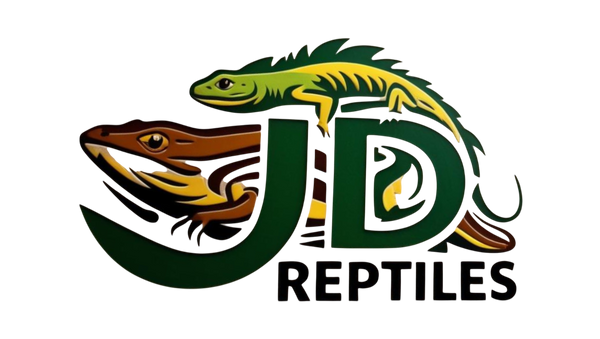Boa Constrictor Care Sheet

Scientific Name: Boa constrictor
Common Names: Boa Constrictor, Red-Tailed Boa
Origin: Central and South America
Average Size: 6-10 feet (1.8-3 meters), with some individuals reaching up to 13 feet
Lifespan: 20-30 years in captivity
Overview
Boa constrictors are large, non-venomous snakes known for their powerful constricting abilities and docile nature. They are one of the most popular pet snakes due to their manageable size, striking appearance, and relatively calm temperament when properly handled. Despite their size, boa constrictors make excellent pets for experienced reptile keepers.
Housing Requirements
Enclosure Size
- Young Boa Constrictors (under 3 feet): Minimum 40-gallon tank (3 feet long)
- Adult Boa Constrictors (over 6 feet): Minimum 6x3 feet enclosure, but larger is better (e.g., 8x4 feet) for better roaming space.
Boa constrictors are semi-arboreal, meaning they enjoy both climbing and ground activities. Providing a spacious enclosure that encourages natural behavior is crucial.
Enclosure Setup
- Substrate: Use coco husk, aspen shavings or cypress mulch. Avoid cedar or pine, as they can be harmful to snakes.
- Hides: Provide at least two hides—one on the warm side and one on the cool side of the enclosure—to give your snake a sense of security.
- Climbing: Offer branches, logs, or rocks for climbing, as boas often perch and explore at different heights in the wild.
- Water: A large, shallow water dish should be provided for drinking, soaking, and thermoregulation.
Temperature & Humidity
-
Temperature Gradient:
- Hot side: 85-90°F (29-32°C)
- Cool side: 75-80°F (24-27°C)
- Basking Spot: Create a basking area with temperatures around 90°F (32°C).
- Nighttime Temperature: Maintain temperatures around 75-80°F (24-27°C) during the night.
- Humidity: Keep humidity levels between 50-60%. Maintain higher humidity (60-70%) during shedding periods.
Proper monitoring with a hygrometer and thermometer is essential to ensure your boa’s environment is stable and conducive to health.
Feeding
- Diet: Boa constrictors are carnivores and feed primarily on mammals (such as rats, mice, and rabbits), but they may also consume birds and other small animals in the wild.
-
Feeding Frequency:
- Young Boa Constrictors (up to 3 feet): Feed every 7-10 days.
- Adult Boa Constrictors (over 6 feet): Feed every 10-14 days, depending on the size of the prey.
- Prey Size: Offer prey items that are the same width or slightly larger than the snake’s body. Overfeeding or providing prey that is too large can cause health issues.
- Feeding Method: Always use tongs to offer food. Live or thawed, appropriately sized prey items may be offered. Use tongs to avoid associating hands with food. Ensure frozen food is fully thawed before feeding to avoid injury.
Shedding
Boa constrictors shed their skin as they grow. Proper humidity (60-70%) is essential during shedding periods to prevent stuck shed.
- Shedding Box: Provide a humid hide filled with damp sphagnum moss to help during the shedding process.
- Signs of Shedding: A snake’s eyes will appear cloudy or blue before shedding, and it may become more secretive or inactive during this time.
Handling
- Temperament: Boa constrictors are generally calm and can tolerate regular handling, though they can be more active during feeding or shedding times.
- Handling Frequency: Handle your snake regularly to promote tameness, but avoid overhandling to prevent stress. It’s best to start with short sessions and gradually increase them as the snake becomes accustomed to human interaction.
- Safety: Always support the entire body of the snake when handling it. Avoid grabbing the snake’s head or neck, as this may cause stress or injury.
Health & Veterinary Care
-Common Health Issues:
-
- Respiratory infections (often linked to improper humidity or temperature)
- Internal parasites (such as mites, ticks, or worms)
- Obesity or regurgitation (from improper feeding or too large prey)
-Routine Checkups: Schedule annual checkups with a vet who specializes in reptiles to ensure your boa constrictor remains healthy.
-Signs of Illness: Lethargy, lack of appetite, abnormal feces, labored breathing, or visible wounds may indicate illness.
-Signs of Stress: Hiding more than usual, loss of appetite, or defensive behavior can indicate stress, which may be caused by improper environmental conditions, handling, or lack of enrichment.
Breeding Information
- Sexing: Male boas tend to be smaller and have slightly longer tails compared to females.
- Breeding Season: Boas usually breed in the cooler months (fall and winter). Females can give birth to live young, typically between 15-64 babies in a single litter, though the number can vary.
- Pregnancy & Birth: Females can gestate for about 5-6 months. Boas are viviparous, meaning they give birth to live young rather than laying eggs.
Conclusion
Boa constrictors are magnificent and relatively docile snakes, making them popular pets for experienced reptile keepers. They require a large, properly equipped enclosure, appropriate feeding, and regular health care to thrive. With the right care, a boa constrictor can live a long, healthy life and become a calm, interactive companion.
Note: Always thoroughly research and ensure you're prepared for the long-term care and commitment of owning a boa constrictor. They require dedication, space, and the right environment to flourish in captivity.
